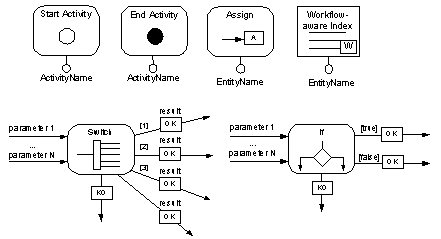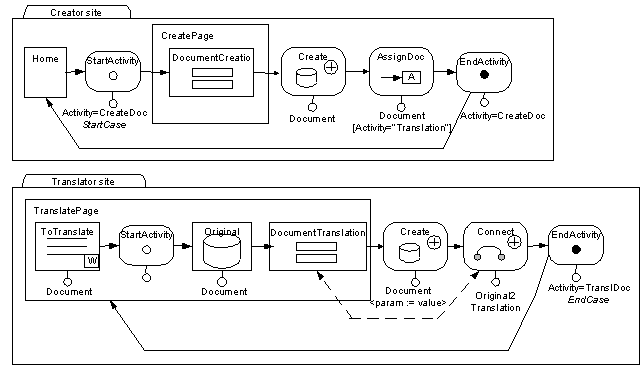
(This
research is part of the WebSI (Web Service Integration) project, funded by the
EC in the Fifth Framework)
While the Web consolidates as the
ubiquitous application delivery platform, the features of Web applications
evolve to cover new requirements, like the capability of managing complex
workflows spanning multiple users and organizations. This scenario challenges
the Web engineering methods to address a broader class of applications. This
paper introduces Workflow Driven Hypertexts, defined as Web-enabled hypertextual
applications serving the workflow of multiple users, and proposes a design
method integrating process, data, and hypertext modeling, expressly conceived to
support the development of this class of applications.
Web site design, web site management, workflow, application integration.
Web engineering is about
applying the principles, techniques, and best practices of software engineering
to Web application development. One
of the key ingredients of software engineering is conceptual modeling, that is,
the ability of describing the properties of an application at a high-level, for
the purpose of exchanging requirements and automatically generating the
implementation code. Conceptual modeling has been successfully applied to
hypertextual applications for the Web [3, 2] and is gaining momentum also in the
market of software development tools.
However, as time passes, the
mission of Web applications evolves, from online information browsing to
full-fledged collaborative applications, supporting workflows spanning multiple
individuals and organizations. In this paper we propose a fusion of data,
hypertext, and workflow modeling concepts and methods into a novel approach for
modeling lightweight Web-enabled workflows; this approach extends the benefits
of high-level conceptual modeling and automatic code generation to a much
broader class of Web applications.
Integrating hypertexts with
workflows means delivering Web interfaces that permit the execution of
activities and embody constraints that drive the navigation of users. We call
these applications workflow-driven hypertexts (WFdHT, for short).
Figure
1
pictorially
contrasts the characteristics of workflow managements systems, of hypertext
applications, and of WFdHTs. "Pure" workflow management systems are
characterized by a rich set of constraints, do not allow free navigation, and
expose only the data needed for accomplishing the workflow objective.
"Pure" hypertexts, at the opposite, do not constrain navigation nor
establish the accessible information a priori. WFdHTs lay in the middle of the
spectrum. Constraints, the degree of navigation freedom, and the amount of
displayed information can be tuned to obtain different application flavors.

Figure 1 – Hypertexts vs. workflows
We advocate a development
process for WFdHTs centered on conceptual modeling, blending three
ingredients, representing orthogonal perspectives:
·
The process model
represents the process to be executed, in terms of the activities that compose
it, their precedence constraints, and the actors in charge of executing each
activity.
·
The data model
represents the domain objects published and manipulated in the application, and
possibly the meta-data necessary for implementing the application (e.g., data
about the users, auditing data, and so on).
· The hypertext model specifies the elements of the interface for executing the activities, in terms of the pages delivered to the user, the content published in each page, the operations that can be invoked from the interface, and the links necessary to enable navigation and operation invocation; the boundaries of activities (i.e., where in the application interface an activity can be started and terminated), and the operations necessary to track the execution of the process.
We have defined these features
as an extension of the WebML language [1], a high-level notation for specifying
Web applications. In WebML the database content is described using the
Entity-Relationship model, and hypertexts are represented as graphs of pages
to be presented on the Web. Pages enclose content units,
representing atomic pieces of information to be published (e.g., indexes listing
item lists, details of a single object, entry forms, and so on); content units
have a selector, which is a predicate identifying the entity instances to
be extracted from the underlying database and displayed by the unit. Pages and
units can be connected with links to express a variety of navigation
effects. Besides content publishing, WebML allows specifying operations,
like creating, modifying and deleting entities and relationships, sending
e-mail, login and logout, e-payment, and so on. Further details about WebML can
be found in [1].
The extensions required for
supporting WFdHT include the addition of some standard entities to the data
model (for recording activities, activities instances and process cases) and of
few primitives to the hypertext concepts (for defining activities, for assigning
objects to activities, and for expressing process constraints). The new
hypertext primitives are graphically represented in Figure 2
. Start and end activity units
delimit the portion of hypertext associated with the execution of an activity.
They can be tagged respectively as the start of the case, when the activity to
start is the first one of the entire process, or, dually, as the end of the
case, when the activity is the last one of the entire process. Assign operations
are conceived for connecting an application object (or a set of objects) to an
activity instance, typically to specify the future job to be performed on the
object. Objects connected to the instances of a particular activity can be
retrieved by means of workflow-aware content units (e.g. indexes of such
objects). Finally, if and switch units can be used to express
navigation conditions. Together with assign/workflow-aware content units, they
allow to represent any process constraint described by the process model.

Figure 2
– Workflow primitives
Example. Figure 3 presents a WFdHT implementing a simple process consisting of two activities performed by two different users: the creation of a document and its translation. Two hypertexts (Creator and Translator sites) represent the operations required for performing the two activities. In the first hypertext the first kind of user starts the process and the creation activity by following a link exiting the home page: the activity consists in filling a form; when submitted, a new document is created and assigned to the translation activity (by means of the assign operation). The activity is ended and the user is led back to the home page. In the second hypertext the translator first selects a document to be translated from an index showing the documents assigned to the translation activity (through a workflow-aware index unit), then the translation activity starts for the selected document. The user fills in a form with the translation, and a new document is created and associated with the original one. This activity ends the whole process.

Figure
3
– Hypertext implementing a simple workflow
The modelling approach briefly introduced in this paper has been experimented in the context of a real-world CASE tool, called WebRatio [4], which supports the model-driven development of "traditional" Web applications. Our ideas have been benchmarked in the development of a real workflow-driven Web application (www.aceradvantage.com). The application deals with the process of requesting, checking, and activating a warranty extension for laptops and personal computers, which requires the execution of a workflow spanning several individuals and business units of the service provider. The application is a perfect representative of the concept of WFdHT, because it requires the use of hypertextual interfaces, to which the customer is accustomed, the delivery of data (e.g., the warranty contracts) and the enforcement of process constraints. The application was successfully delivered in a very short time (five weeks), and has been generated automatically from a conceptual model described with WebML enhanced with workflow primitives.